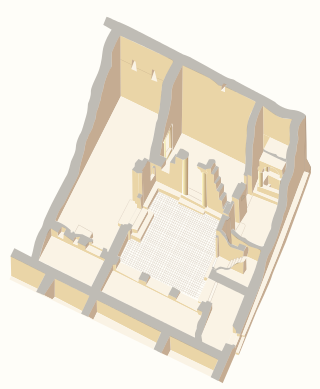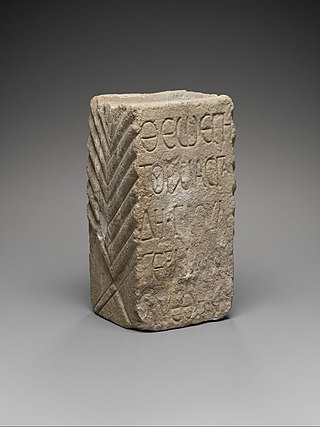

The Temple of Adonis in Dura-Europos was discovered by a French-American expedition of Yale University led by Michael Rostovtzeff and was excavated between 1931 and 1934.


The Temple of Adonis in Dura-Europos was discovered by a French-American expedition of Yale University led by Michael Rostovtzeff and was excavated between 1931 and 1934.
The temple complex was the last great temple of the city to be built under Parthian rule (113 BC – AD 165). It consists of a number of buildings grouped around a courtyard. It takes up half an insula (city block), with the surrounding residential buildings forming the boundaries of the temenos. Several different rooms with benches on all the walls were grouped around the courtyard. On the north side, there was a portico with two columns. Two reliefs were found here, one depicting either Atargatis or Tyche, and the other of the god Arsu riding a camel. [1] The actual temple was located in the south and had consisted of a pronaos and the actual naos. Wall paintings which were discovered in a fragmentary state, depicted a state and a family making an offering to the god on a fire altar at left. The scene has been reconstructed.
Several inscriptions found in the sanctuary make it possible to follow the history of the sanctuary in detail. It can be divided into two construction phases. Three inscriptions dating to AD 152, 152/152, and 157/158 mark the first phase. The oldest inscription (July or August 152) was located on the lintel of the door to the pronaos. It is not well preserved, but the dating is secure. [2]
The main sanctuary was thus probably founded in AD 150. A second phase of construction took place in the years 175–182. On 24 September 175, Gorpiaeus Thaesamsus dedicated an altar with an inscription which explicitly named Adonis. [3] In 181/182 (year 493 of the Seleucid era, which is employed by all the sanctuary's inscriptions), two people called Solaeas and Boubaues erected a peristyle and a wine cellar. [4]

Dura-Europos was a Hellenistic, Parthian, and Roman border city built on an escarpment 90 metres above the southwestern bank of the Euphrates river. It is located near the village of Salhiyé, in present-day Syria. Dura-Europos was founded around 300 BC by Seleucus I Nicator, who founded the Seleucid Empire as one of the Diadochi of Alexander the Great. In 113 BC, Parthians conquered the city, and held it, with one brief Roman intermission, until 165 AD. Under Parthian rule, it became an important provincial administrative centre. The Romans decisively captured Dura-Europos in 165 AD and greatly enlarged it as their easternmost stronghold in Mesopotamia, until it was captured by the Sasanian Empire after a siege in 256–257 AD. Its population was deported, and the abandoned city eventually became covered by sand and mud and disappeared from sight.

The Dura-Europos synagogue was an ancient synagogue uncovered at Dura-Europos, Syria, in 1932. The synagogue contains a forecourt and house of assembly with painted walls depicting people and animals, and a Torah shrine in the western wall facing Jerusalem. It was built backing on to the city wall, which was important in its survival. The last phase of construction was dated by an Aramaic inscription to 244 CE, making it one of the oldest synagogues in the world. It was unique among the many ancient synagogues that have emerged from archaeological excavations as the structure was preserved virtually intact, and it had extensive figurative wall-paintings, which came as a considerable surprise to scholars. These paintings are now displayed in the National Museum of Damascus.

The Dura-Europos church is the earliest identified Christian house church. It was located in Dura-Europos, Syria, and one of the earliest known Christian churches. It is believed to have been an ordinary house that was converted to a place of worship between 233 and 256, and appears to have been built following the Durene tradition, distinguished by the use of mud brick and a layout consisting of rooms encircling a courtyard, which was characteristic of most other homes built in the Dura-Europos region. Prior to the town being abandoned in 256 during the Persian siege, the Romans built a ramp extending from the city wall which buried the church building in a way that allowed for the preservation of its walls, enabling its eventual excavation by archaeologists in 1933. It was less famous, smaller, and more-modestly decorated than the nearby Dura-Europos synagogue, though there are many similarities between them.

Clark Hopkins was an American archaeologist. During the 1930s he led the joint French-American excavations at Dura Europos. In later years he was professor of art and archeology at the University of Michigan.

Parthian art was Iranian art made during the Parthian Empire from 247 BC to 224 AD, based in the Near East. It has a mixture of Persian and Hellenistic influences. For some time after the period of the Parthian Empire, art in its styles continued for some time. A typical feature of Parthian art is the frontality of the people shown. Even in narrative representations, the actors do not look at the object of their action, but at the viewer. These are features that anticipate the art of medieval Europe and Byzantium.

Yarhibol or Iarhibol is an Aramean god who was worshiped mainly in ancient Palmyra, a city in central Syria. He was depicted with a solar nimbus and styled "lord of the spring". He normally appears alongside Bel, who was a co-supreme god of Palmyra, and Aglibol, one of the other top Palmyrene gods.

The Temple of the Gadde is a temple in the modern-day Syrian city of Dura-Europos, located near the agora. It contained reliefs dedicated to the tutelary deities of Dura-Europos and the nearby city of Palmyra, after whom the temple was named by its excavators. The temple was excavated between 1934 and January 1936 by the French/American expedition of Yale University, led by Michael Rostovtzeff.

The Temple of Bel, also known as the Temple of the Palmyrene gods, was located in Dura Europos, an ancient city on the Euphrates, in modern Syria. The temple was established in the first century BC and is celebrated primarily for its wall paintings. Despite the modern names of the structure, it is uncertain which gods were worshipped in the structure. Under Roman rule, the temple was dedicated to the Emperor Alexander Severus. In that period, the temple was located within the military camp of the XXth Palmyrene cohort.

The Temple of Zeus Cyrius stood in the city of Dura-Europos (Syria) and The construction of the original temenos is dated by the inscriptions above its altar and on its cult reliefs to the end of the second decade of the first century after Christ. It was excavated in 1934 by a joint French-American expedition.

The Temple of Zeus Theos at Dura Europos was built in the second century AD and was among the most important sanctuaries of the city. The structure was located in the centre of the settlement. It had an area of around 37 m2 and took up half an insula. It was excavated by an American-French team between December 1933 and March 1939.

The Palace of the Dux Ripae was the largest and most important building in Dura-Europos during the period of Roman rule. According to the inscriptions, the Palace was erected under Elagabalus and it seems to have survived until the Sassanid conquest of Dura-Europos in AD 256.

The so-called Dolicheneum is a temple in Dura Europos in the east of today's Syria, where Jupiter Dolichenus and god called Zeus Helios Mithras Turmasgade may have been worshiped. The remains of the temple were excavated in 1935/36, but results were never fully published.

The so-called necropolis temple was in the north of Dura-Europos, outside the city walls, about 150 m northwest of the main gate.

The Mithraeum of Dura Europos was found during excavations in the city in 1934. It is considered to be one of the best-preserved and best-documented cult buildings of Mithraism.

Turmasgade is a little known god, known from about 10 inscriptions from the Roman Empire. The name 'Turmasgade' is Aramaic and means "mountain of worship" or "mountain of sanctuary". Tur means "mountain"; msgd - "worship" or "sanctuary". This may indicate that Turmasgade was a holy mountain, but also a deity. In some inscriptions he is identified with Zeus, but in other there is no evidence of such identification. It has been suggested that the god from the originates from the Kingdom of Commagene. So far there are only nine certain mentions of the god, most of which come from the east of the Roman Empire; one inscription comes from Trier, another from Rome. A sanctuary of God has been excavated in Dura Europos, Dolicheneum.

The Temple of Aphlad was an ancient temple located in the southwestern corner of Dura Europos, and dedicated to the god Aphlad. Aphlad was originally a Semitic Mesopotamian god from the city of Anath, and presence of his cult in Dura is revealing of its religious and cultural diversity. The temple itself consists of an open courtyard with multiple scattered rooms and altars, similar to the Temple of Bel, which was located in an analogous position in the northwestern corner of Dura.

The temple of Artemis Azzanathkona is located in Dura Europos in the east of present-day Syria, and was dedicated to a syncretic belief of Artemis and Azzanathkona.

The Temple of Atargatis in Dura-Europos was one of the main temples of the city. The temple was built in the first century AD, when the city was under Parthian rule, and excavated in 1928–1929 under the direction of Maurice Pillet.

The Temple of Zeus Megistos is in Dura-Europos in the east of the city in a part of the city that is modernly referred to as the Acropolis. It was one of the main temples of the city, the oldest construction phases of which perhaps go back to the time when the city was under Greek rule. The temple is not well preserved and the results of its excavations are not fully published. Several times the temple has been the target of excavations. The first excavations took place in 1928–37. The ceramics have hardly been recorded, which makes dating the older layers more difficult. The excavators presented some reconstructions of the oldest Greek temple. In particular, the more recent excavations from 1992 and 2002 raise doubts about older reconstructions and interpretations.

The building that is referred to as the Priests' House, or House of Priests, at Dura-Europos near the village of Salhiyah in eastern present-day Syria, is one of three buildings that was excavated in block H2. It is hypothesized to be the home of priests from the Temple of Atargatis based on its proximity to the two neighboring temples and graffiti found in the third Excavation season.